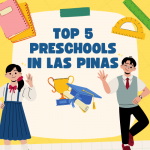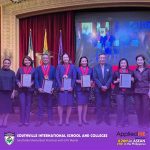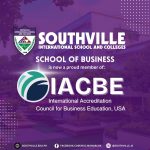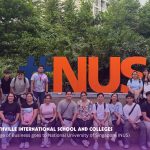Preschoolers are naturally curious. They are eager to explore their surroundings and know how things work. To engage young minds, the Preschool teachers of Southville International School and Colleges develop the project approachmethod in teaching young children.
Project Approach involves children in their learnings by letting them decide which among their interested topics are worth learning. Project Approach has three phases: 1) Beginning the Project, 2) Developing the Project and 3) Concluding the Project. In Phase 1, Beginning the Project, the class decides on the topic through voting. Learning the chosen topic together, as a class, throughout the term is Phase 2, Developing the Project. For Phase 3, Concluding the Project, the class will hold a program to culminate their learnings.
Below is an abridged narrative on what a typical Southville preschool class does in the classroom.
BEGINNING THE PROJECT
For the class of Senior Kinder Lime, candy is a common interest. The students often visit an informational picture book in the classroom’s reading corner. They were enticed by how candies are made; and often pretend to retell the process of making candies while looking at the pictures. The students also favors candy in their play pretend cooking. That’s why it was no surprise when candy was chosen to be the class project.
Experience. Knowledge. Wonder. Question.
What I Experience and Know About Candies:
- Fruit candies are healthy. – Aedam
- I tasted yummy cotton candy and lollipop. – Akita
- Some candies have different flavors. – Marcus
- Bubble gums have bubbles. – Lucy
- Cherry is a flavor. – Sukhmeen
- Hard candies are not good. – Sajan
- Candies are sweet. – Sophia
- When you eat candies, your teeth get hurt. – Christian
- I eat yummy candies. – Jun Hwi
- I like Chokki candy. – Eun Bi
- I like fruit candies. – Iain
- I like Pochie candy. – Patrisha
- Candy flavors can be banana, strawberry, and apple. – Santina
- Lollipops are yummy, tastes like fruits. – Alexa
- Candies are made. – Princess
What I Wonder Questions:
- Are candies healthy or not? – Marcus
- What are candies made of? – Akita
- How do we make candies? – Princess
- How can candies be healthy? – Sukhmeen
- How do candies get hard? – Lucy
- How do candies give us cavities? – Santina
- Is popsicle a candy? – Sophia and Alexa
- I wonder how candies get their color and flavor. –Eun Bi, Jun Hwi
DEVELOPING THE PROJECT
To learn more about candies, the preschoolers involved their senses to “get to know” the common candies available in the market. They used skittles, marshmallows, jellies, gum, and mints. Unlike the usual eating of a candy, the class examined the candies by smelling, touching, looking, and tasting them. They checked out the labels and compared the candies by listing the ingredients used to make them. As they listed their observations, they summed up what is common in these candies: SUGAR.
A Visit to the Dentist
Now that the class knows what candies are made of, we now have to find out whether they are good for their teeth.
The preschooler then visited Southville resident dentist, Dr. Sau, to help them learn how candies can be bad to their teeth. He demonstrated that sugar in most candies stick to our teeth and turns into acid. This acid then eats up the enamel, the protective layer of our tooth. Without the enamel the teeth start to decay.
Dr. Sau adviced the childrento brush their teeth regularly, especially after meals. He also stressed the need to be careful with what they eat. He showed a menu of candies to test the students if they can choose well: chocolates versus bananas, Lollipops versus Apple lollies. From there, the students were learning to choose healthy food over commercial candies.
Healthy Candy Making
With their discovery that sugar hurts their teeth, the preschoolers were getting more curious on how to make healthy candies.
The class was delighted to have Mommy DJ Tambot visit and teach them how to make homemade apple fries. They learned that apples are healthy fruits enriched with vitamins, like the saying, “An apple a day, keeps the doctor away.”
Mommy Nithiya and Daddy Suresh also came over and taught the class how to make candies with nuts. The preschoolers learned different kinds of nuts like almonds, pistachios, cashews, raisins, dates, and nuts; and that nuts are packed with protein that is good for the brain.
The Senior Kinder Lime class learned another healthy candy recipe with Mommy Jing. She showed them how to make the sweet and nutritious Pastillas de Leche. The class also learned that milk is healthy because it has calcium, a mineral that makes bones strong.
CONCLUDING THE PROJECT
Senior Kinder Lime has gained much understanding of the topic and has shown interest already for putting “what I know”to “what I can”.
The class saw the importance of eating healthy candies and they want to share what they have learned to kids who also love sweets. They made simple yet healthy candies in class which they shared with their friends in other classes. They talked about the nutritional value of the healthy candy and how it was prepared. They also encouraged the other students to eat healthily and avoid sugary products that are harmful to their teeth. They also brought home fruit jellies for their families to taste and enjoy.
The class also celebrated their learning through a picnic activity. While they were munching on apples and melons, marshmallows and popcorns, they talked about how the healthy candy project helped them choose what is good for their health.
SUMMATIVE EVALUATION:
The project has been a way to assess and apply the skills that the preschoolers have been learning throughout the year. It paved way to engage the children through expressing their creativity in making healthy candies. Their attention to detail and increased ability to interact positively with others were evident.
Knowledge and skills developed in the children are as follows:
Knowledge:
Candies are made of sugar that may turn to acid when eaten.
Fruits and vegetables contain vitamins and minerals that are good for our teeth.
Candies have flavor that come from fruits.
Healthy candies are prepared using real fruits or vegetables.
Squash gives us vitamin A while oranges give us Vitamin C.
Skills:
Expressing creativity in arts
Expressing creativity in language and communication
Performing using mathematical skills
Appreciating others’ talents
Collaborating with others
Interacting with others
Forming well thought-out questions
Organizing and following a definite procedure
Evaluating one’s output against a standard
Practicing the value of self-control and discipline.












